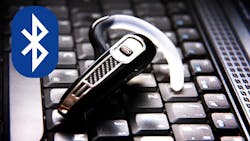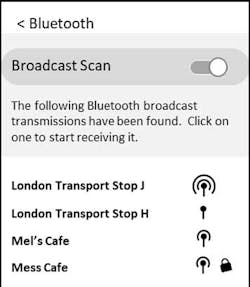Introducing Bluetooth LE Audio
What you'll learn:
- Benefits derived from the new Bluetooth LE Audio standards and specs.
- The arrival of Bluetooth broadcast audio.
- A look at how the broadcast streams work.
Over the last 20 years, Bluetooth wireless technology has become the standard for personal audio. From its initial use in headsets for hands-free mobile calls, it has encompassed high-quality music streaming, growing in popularity with the increasing availability of smartphones and streaming applications. The arrival of Apple’s AirPods and the subsequent enthusiasm for earbuds has resulted in this becoming the fastest-growing consumer product sector we’ve ever seen.
Now, the Bluetooth SIG just recently launched its new Bluetooth LE Audio set of standards. It consists of a comprehensive set of specifications designed to support the next 20 years of audio development, allowing the industry to offer even more innovation in both products and applications.
Requirements from the hearing-aid industry prompted Bluetooth LE Audio development. Although separate from the consumer audio market, hearing aids have had to solve many problems that are still challenging for consumer earbuds.
Because they’re worn all day, without the opportunity for recharging, they need to operate on little power. In many cases, users may wear different hearing aids in each ear—something that most current true wireless stereo (TWS) earbuds don’t allow, as they rely on proprietary methods to keep the earbuds synchronized with each other.
Finally, hearing aids support broadcast systems, where multiple wearers can connect to the public, inductive loop systems known as a telecoil.
All of these features have enormous use for everyday audio use cases, but they had fallen into the “too hard” category. It also was apparent that the existing Bluetooth audio specifications were limiting, with the Hands Free Profile designed predominantly for cellular calls and the A2DP specifications confined to streaming music to a single set of earbuds or headphones.
Recent developments, such as voice assistants and the emergence of spatial audio and augmented reality, made it clear that far more flexibility was needed. It prompted the industry to come together to deliver Bluetooth LE Audio to support a new generation of audio applications.
Updating the Basics
At the heart of the new specifications is the move to use Bluetooth Low Energy, released in 2010 as a much lower power option, intended for devices like wearables and health sensors. It has now extended to support multiple audio streams.
The standard has introduced a new audio codec—the LC3—to make audio even lower power. The LC3 has been optimized to support both voice and music applications, providing the same subjective quality as current audio codecs at around half the bit rate. This means that smaller amounts of information need to be transmitted, lowering the power consumption and reducing the likelihood of interference from other radio sources.
Designers can use such new flexibility to reduce power and increase battery life. Alternatively, they can transmit multiple streams for spatial audio, support multiple languages, or use the extra resources they have gained for more efficient audio algorithms, like noise cancellation.
Broadcast Audio: A New User Experience
Those features improve today’s wireless audio experience, but the real game-changer introduces a broadcast capability. At its simplest, this allows a transmitter to send the same audio streams to multiple devices. Since the arrival of Sony’s Walkman, back in 1979, friends have shared earbuds to listen to music. With Bluetooth LE Audio, you really can cut the cables, allowing any number of people to listen to the same audio stream.
However, this isn’t just about sharing personal music from your phone.
Broadcast audio can be used for public announcements, such as travel information. That’s a use case similar to what hearing-aid wearers can experience today with the inductive loop telecoil system. With Bluetooth LE Audio, this capability can extend to high-quality music received by any LE Audio earbud or hearing aid.
These broadcast transmitters will be low cost and easy to install. Therefore, any venue, such as a gym, bar, or coffee shop, can provide multiple audio streams for their customers, either as background music or to provide audio to accompany multiple TVs.
Finding and connecting to these streams is simple and doesn’t require pairing. These broadcast streams include metadata that describes their content, allowing users to select what they want to hear if there are multiple different broadcasters.
In the same way that phones can detect Wi-Fi access points, a similar scan can provide a list of broadcast audio streams within range (see figure). Clicking on any broadcast sources would switch your earbuds to receiving the selected audio stream. The audio would go directly from the broadcast source to your earbuds—the phone only acts as a controller, essentially becoming a remote control.
The broadcast streams also can be encrypted and authenticated, making them prime for ad-hoc, private conversations, such as talking to someone at a ticket desk or hotel reception. It means that you’re likely to wear an earbud for longer, much like a hearing-aid user; thus, the lower power consumption of LE Audio is particularly beneficial.
Because broadcasts are one way, they take advantage of the higher link budget from an infrastructure transmitter to the earbud (the reverse link budget is limited by power constraints and antenna size within an earbud or hearing aid). The range is therefore significantly greater than conventional Bluetooth or Wi-Fi. Hence, a single broadcast transmitter can cover large rooms and venues.
Wide-Ranging Support
The new Bluetooth LE specifications support an extensive range of applications. The industry support has been excellent, with multiple silicon vendors offering compliant chips for transmitters (typically phones, TVs, and independent broadcast devices) as well as for earbuds, headphones, and speakers.
The underlying Core features were introduced in the 5.2 release, which means that many devices are already hardware-capable. Although it always takes time from the adoption of a wireless standard to products and applications appearing in the market, in the case of Bluetooth LE Audio, it looks as if we will see the first products appearing very soon.
To provide more detailed information, I’ve just published a book to help explain how the various specifications fit together and present the potential applications. Called “An Introduction to Bluetooth LE Audio,” it’s now available in paperback or hardback from Amazon. A digital version is also available for download from the Bluetooth SIG website.
About the Author
Nick Hunn
Bluetooth SIG
Nick Hunn serves on the Chair of the Bluetooth SIG Hearing Aid Working Group and Vice Chair of the Generic Audio Working Group

